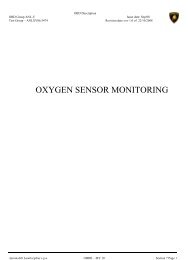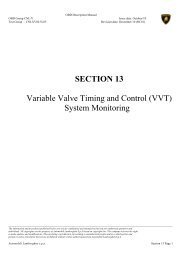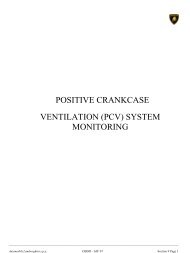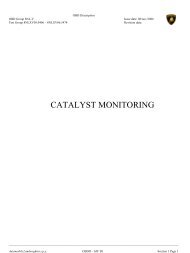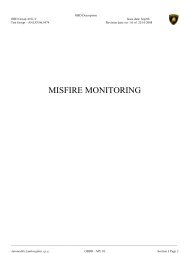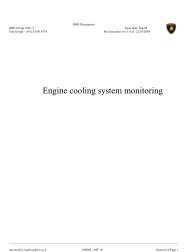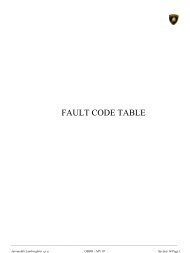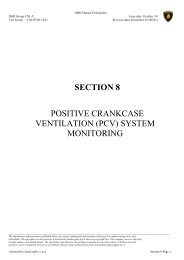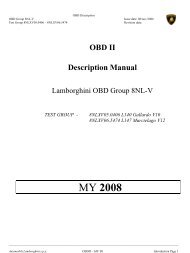Misfire monitoring - Automobili Lamborghini Holding Spa ...
Misfire monitoring - Automobili Lamborghini Holding Spa ...
Misfire monitoring - Automobili Lamborghini Holding Spa ...
- No tags were found...
You also want an ePaper? Increase the reach of your titles
YUMPU automatically turns print PDFs into web optimized ePapers that Google loves.
<strong>Automobili</strong> <strong>Lamborghini</strong> s.p.a. OBDII – MY 07 Section 3 Page 2This system allows us to detect misfire under all positive torque engine speed and loadconditions, from the engine start.Due to the choices made for the exhaust system, the malfunction criteria - which is more severe - islinked to the increase of emission levels. Our misfire <strong>monitoring</strong> system is able to detect a 2.5%misfire condition which causes an emission increase exceeding 1.4 times the applicable FTP standard;this level is more severe than the one required by CARB (paragraph (e) (3.2.2)(A)).The system is able to detect which cylinder is affected by misfire in single misfire conditions; in thecase of multiple misfires, the system can detect which is the affected cylinder bank.If more than 90 percent of the detected misfires occur in a single cylinder, the appropriate fault codeindicating the specific misfiring cylinder is stored. If two or more cylinders individually have morethan 10 percent of the total number of detected misfires, a multiple cylinder fault code is stored.___________________________________________________________________________________________________________
<strong>Automobili</strong> <strong>Lamborghini</strong> s.p.a. OBDII – MY 07 Section 3 Page 3Basic theory and algorithm___________________________________________________________________________________________________________
<strong>Automobili</strong> <strong>Lamborghini</strong> s.p.a. OBDII – MY 07 Section 3 Page 5The most important part of the algorithm is the Fourier analysis of the exhaust pressure signal.The algorithm’s logical steps are the following:1. Check if engine is on.2. If engine is on, verify if conditions (RPM, MAP, TH2O, TAIR) are suitable for misfire detection(positive torque conditions).3. If engine conditions are suitable for misfire detection perform the next step.4. Acquire the output signal of the pressure transducers (one for each bank of the exhaust system,positioned before the close coupled catalytic converter).5. Perform the Fourier transform of the pressure signal over every sampled engine cycle.6. Perform the analysis of the amplitudes of the first three harmonics (The first harmonic has aperiod that equals the engine cycle, the second a period that equals engine Rpm, the third a period thatequals a third of the engine cycle).7. Define a “misfire index” as a combination of the amplitudes of the three harmonics.8. Perform the <strong>Misfire</strong> preliminary detection by comparing the “misfire index” to a stored thresholdvalue, a function of engine Rpm , load and ENCS status.9. If the threshold value is exceeded, identify whether the misfire is single or multiple. Thisdetection is possible comparing the three harmonics amplitudes to their reference ranges. If all thethree harmonic amplitudes are within the relevant ranges a SINGLE misfire occurred in the enginecycle.10. Calculate the first harmonic phase and compare it with the values stored in the ECU (function ofRpm, load and ENCS status). This comparison defines the single cylinder that misfired.11. Calculate the misfire percentage, by verifying the number of misfiring engine cycles over apredetermined number of engine cycles.12. Verify whether the percentage reaches the value that would cause the catalyst damage. If this istrue the MIL will blink until misfire is detected. At the same time, if misfire is single, the relevant faultcode identifying the cylinder will be stored. A freeze frame of engine conditions will be stored too.If the misfire percentage reaches the value that would cause emission from a durabilitydemonstration vehicle to exceed 1.5 times the applicable FTP standard, evaluated in 1000 revolutionincrements, according to subsection. (e) (3.2.2)(A and C), then a fault code identifying the cylinderwhich is undergoing misfire or a fault code relevant to multiple misfire will be stored.A freeze frame of engine conditions will be stored too. The Pending Fault code will be stored nolater than the next driving cycle in which misfire is detected, unless driving conditions similar to thoseunder which misfire was originally detected have been encountered without an indication of misfire, inwhich case the temporary fault code can be erased.___________________________________________________________________________________________________________



